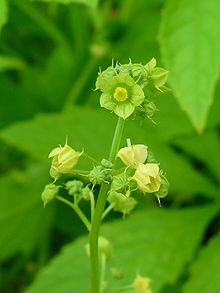Cyclanthera pedata
| Cyclanthera pedata | ||||||||||||
|---|---|---|---|---|---|---|---|---|---|---|---|---|

Cyclanthera pedata |
||||||||||||
| Systematics | ||||||||||||
|
||||||||||||
| Scientific name | ||||||||||||
| Cyclanthera pedata | ||||||||||||
| ( L. ) Schrad. |
Cyclanthera pedata (in Quechua Achoc (c) ha , Achojcha or Archucha and Kaywa , from Spanish caihua , caigua , caiba , caygua [ kaiwa ], German also called "Korila", "Inca cucumber" or "olive cucumber") is a type of plant from the family of cucurbits serve (Cucurbitaceae), whose leaves and fruit of the human diet.
description
The species is an annual , strong climber that is about 4–5 meters or more long. It has bald, ribbed stems that smell strongly cucumber-like when squeezed . The ribbed petioles are 5 to 15 inches long. The almost bare, finely papillae and alternate leaves are large and cut 5 to 7 times, hand- or foot-shaped, with partially divided and pointed, prickly-pointed lobes. The lobes have entire margins at the base and partially removed at the front, bulged and roughly to finely pointed. The sheet size ranges from 6 to 19 × 8 to 24 centimeters. The lobes are 7-16 centimeters tall, with the middle one being the largest, undivided they are ovate to -lanceolate or elliptical, the divided ones are obovate in outline. There are long tendrils in two or more parts .
The species is monoecious . The male flowers are in panicles 15 to 30 centimeters long , the female appear individually. The five-fold, short-stalked flowers with a double flower envelope are greenish-yellow to white and relatively small for the family. The calyx lobes are narrow and subpulate. The fine-haired, papillae and keeled petals are egg-shaped. The stamens are fused tubular to a synandrium, with disc-shaped fused anthers. The unilocular ovary is inferior and almost sedentary scar is disc-shaped.
The more or less pointed, egg-shaped and longitudinally streaky-veined to slightly ribbed, smooth and sometimes slightly humped fruit , berry (armored berry) is often partly hollow. It is greenish and 5 to 16 inches long. Sometimes it has some soft spines . The 8–13, somewhat flattened, slightly textured and pear-shaped seeds , with a small neck and roughly blunt, broken base, resemble turtles and are dull dark brown to blackish. They are about 8-14 millimeters long. The whitish flesh is relatively thin and spongy.
The chromosome number is 2n = 32.
distribution
The species is native to South America , especially the Andes . It occurs in Central America , Colombia , Venezuela , Peru , Ecuador , Bolivia and Argentina . It is widely cultivated there and also wilds. The species is also cultivated in Asia ( India , China ). It is relatively cold tolerant and thrives at an altitude of 2800 meters. It also grows at temperatures just above 0 ° C.
use
The leaves and young sprouts are eaten raw or cooked. The young fruits are eaten raw like cucumbers or cooked, the older ones only cooked. When cooking, the seeds are often removed and the fruit is filled with various ingredients. This is where the common English name Stuffed cucumber comes from . The seeds are also edible and are used more medicinally.
literature
- RW Robinson, DS Decker-Walters: Cucurbits. CAB International, Wallingford 1997, ISBN 978-0-85199-133-7 , pp. 111-112.
- Rafael Lira Saade: Cyclanthera pedata. In: Flora Mesoamericana , accessed October 14, 2019.
- Cyclanthera pedata in the Flora of China, Vol. 19.
- Cyclanthera pedata at PROTA.
Web links
- Cyclanthera pedata at Useful Tropical Plants.
- Cyclanthera pedata at CABI Invasive Species Compendium.
Individual evidence
- ↑ James A. Duke: Duke's Handbook of Medicinal Plants of Latin America. CRC Press, 2009, ISBN 978-1-4200-4316-7 , p. 248.
- ↑ RTJ Cappers, R. Neef, RM Bekker: Digital Atlas of Economic Plants. Volume 1, Barkhuis, 2009, ISBN 978-90-77922-59-0 , p. 158.


